When the 2nd World War started, Italy maintained a “non belligerent” status, knowing full well that, if they were to enter in this conflict against France and/or England, it could have ended in a disaster without Germany’s support. Mussolini knew that, if Italy had to enter the war, the perfect year to do that would have been, according to statistics, 1943.
Mussolini was eager to enter the conflict, although his generals advised the opposite because they knew what the real situation of the army, navy and air force was: equipment was old and dated, the soldiers were not all fully equipped, the air force had good pilots but was lacking planes (1780 was the maximum amount of C.R. 42 built vs the 29thousands of B.F. 109) and the navy, pride and joy of Italy, didn’t have too much fuel in his reserves. To top it off, morale was already low and was destined to get worse, since many soldiers were fighting for causes they didn’t believe in. Even the population wasn’t too sure about Italy’s intervention in the conflict, since many remembered what had happened 25 years prior when the 1st world war started and how it inflicted their lives.
Even tactics were outdated. The Italian doctrine, as well as the one of other nations prior to this conflict, was “to copy the last conflict we had” so tactics were based on the fighting of the 1st world war, aka trench warfare and charges against enemy gunfire.
When Italy declared war on France and England on the 10th of June 1940, Mussolini’s speech by the balcony of “Palazzo Venezia” was applauded by a cheering crowd. The military operations that followed, starting by the Italian invasion of France, also known in Italian as: “Battaglia delle Alpi Occidentali” demonstrated how poorly trained, equipped and unprepared the Italian army was.
In this campaign, Italy only managed to capture 832 km² of territory, that came with no industry nor any form of agricultural zones.
BATTLE OF BRITAIN
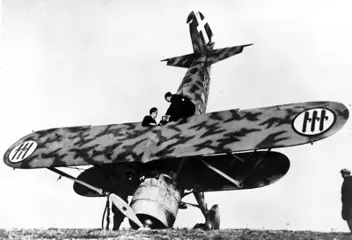
An Italian Aircraft gets inspected by military personnel after a crash landing during the battle of Britain
When the Battle of Britain started, Mussolini insisted on sending units of the Regia Aeronautica, with the “Corpo Aereo Italiano”, thinking that they would have been helpful. In reality, those units didn’t improve the already poor results and the C.A.I. was redeployed in early 1941.
THE GREEK OFFENSIVE
In the meantime, the Italian army invaded Greece on the 28th of October 1940 (symbolic date for the “Marcia Su Roma”), but it all ended in a disaster, since troops had low morale and poor planning. Another factor was that they encountered major resistance by the Greek army and the already formed resistance, and the fact that they were not too well equipped for the mountainous and muddy terrain on the border between Greece and Albania. All this, compared with the help that Greece received from the British, served to drive the Italians back as well as gaining some territory into the Albanian border. Italy tried gaining ground with the “Spring Offensive”, but it all stopped when the troops were pulled back by the Greeks. At this point Mussolini had to call the German Ally and request help from Hitler’s forces, that invaded Greece via Bulgaria and drove the Greek troops back as far as Athens. This prompted the surrender of all Greek forces to the Germans.
THE NORTH AFRICAN CAMPAIGN
The fight in North Africa started immediately after the Italian declaration of war, but not by Italian hands. In fact, the British started the fighting by invading Libya and conquering Fort Capuzzo.
The Italian response soon followed with a counter-offensive into Egypt, followed by the Battle of Sidi Barrani in September, that ended with its recapture by the Brits in December of the same year during “Operation Compass”. Mussolini thought that this time Italy could face the British troops without any support from the Germans, but he was wrong. During Operation Compass the 10th army of the Regio Esercito was destroyed and so he had no choice but to ask Hitler for support. The Fuhrer did so by sending the Afrika Korps with Erwin Rommel “The desert Fox” as commander. Rommel’s orders were to stop at all costs the Commonwealth advance into the Italian North Africa.
When it became clear that he could advance, Rommel and the rest of the Italian forces decided to press again and try and reconquer the territory that they lost. This sudden advance, not blocked by the British, led to the siege of Tobruk and to the capture of the Halfaya Pass. After the Italian and German forces had received supplies and reinforcements from Tripoli, they finally managed to capture Tobruk and advance till 140km from Alexandria, stopped in the famous “First Battle of El Alamein”.
At the end of June Axis forces tried their hands again but failed, and they were defeated by the Eight Army during the “Second Battle of El Alamein”, during which Tripoli was captured in January of 1943. By then, the war in Africa was already well into it’s ending phase, starting with the “Tunisia campaign”.
During this last attempt by the Axis to push back, the Allies were halted just 30km shy of Tunis. In the coming winter, both sides built up their forces and waited. Rommel himself defeated the americans in the Battle of Kasserine Pass, but this wasn’t enough to stop the advancing foe.
Axis forces surrendered on the 13th of may 1943, and the brits took over 275000 prisoners of war.
The last Italian force to surrender was the 1st Italian Army of General Messe, meaning that the north African campaign, along with all the Italian colonies, was lost.
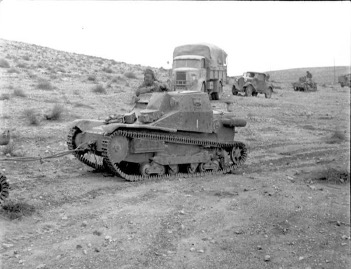
An italian L3/33 during the North African Campaign
THE CSIR
The Csir (Italian Expeditionary Corps in Russia), was the Italian army expeditionary unit sent to fight in the Eastern front, joining the Italian Army in Russia as the 35th Army Corps.
It was formed as an attempt to provide mobile unit to fight on the Russian front.
This unit was created by Il Duce Benito Mussolini to demonstrate to Germany that Italy could help in the attack against the Soviet Union (Operation Barbarossa). It was composed of Three divisions, of whom 2 were semi-motorized units. The last one, the Prince Amedeo Duke of Aosta division was a traditional cavalry unit with some motorized units.
The initial strength was of, approximately, 62.000 men, 5.500 vehicles and 83 planes, not counting the 4.600 horses and mules. These units were, primarily, light infantry and horse cavalry. The Duke of Aosta division even had some obsolete tanks and anti-tank guns, that were no match for the T-34/76.
Operations
The CSIR was sent down in Ukraine, where it made its first contact with the Red Army. It was accompanied by the German 11th Army. In its first encounters, units of the Csir were successful and even managed to capture large parts of soviet prisoners. Its first big victory was at the Battle of Petrikowka, where they captured 10.000 soviet soldiers, creating a good impression on the Germans. On the 20th of October, with the help of the Germans, Italian units were able to capture the city of Stalino (Donetsk).
In July 1942 the CSIR was then incorporated in the far larger ARMIR (Italian army in Russia).
ARMIR
The Italian Army in Russia was created by Mussolini in July 1942 to aid the German offensive in the Soviet Union; it initially had 235.000 soldiers. A good portion of it was made up of Alpini, elite mountain troops, but they were not suited for the large plains of the Russian steppe.
Main operations
On the 11th of December, soviet troops attacked the Italian line near the river Don. Italian troops were outnumbered but managed to hold out until the 19th, when they were ordered to retreat by the central command.
At the same time, the Soviet 21st Army and the 5th tank army had managed to attack and destroy what was left of the Romanians and the Hungarians and were about to encircle what remained of the Italians. This action caused the collapse of the Axis front north of Stalingrad, in fact the ARMIR remained circled but managed to repel the attacking soviets.
On the 14th of January 1943, the Soviets attacked the Alpini, and it became clear soon that their position couldn’t be maintained for long, in fact they decided to burn all the Regimental flags to avoid their capture. In this instance happened the last cavalry charge of the Italian Army, during the Breakthrough at the battle of Nikolaievka, when the italian cavalry charged directly against soviet tanks and troops to evade them and return to axis lines. The last division of the Alpini managed to escape on January 26. Many, if not the majority of the troops were ill, frost-bitten and demoralized.
Records state that, of the 235.000 troops that departed, half didn’t return.
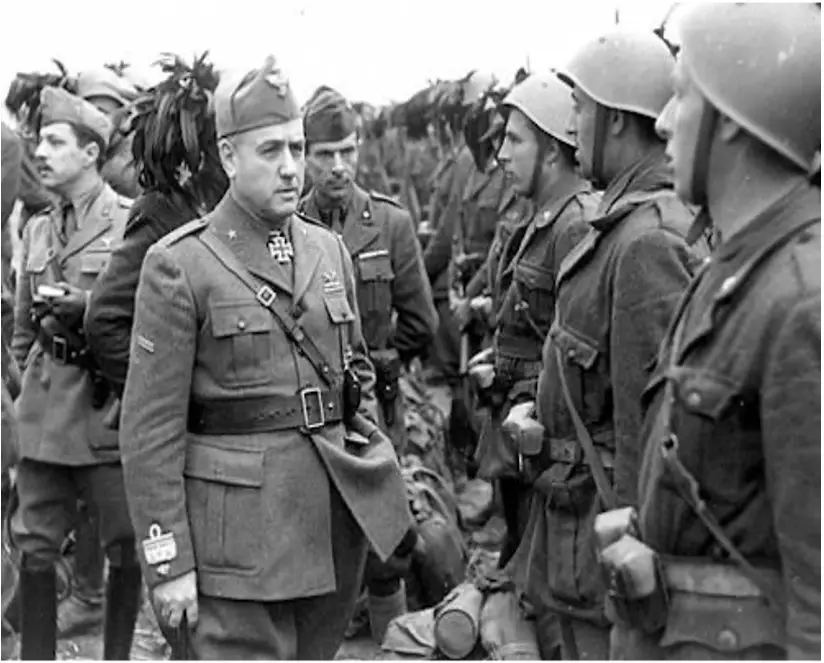
Italian General Giovanni Messe inspecting the troops on the Russian Front
ITALIAN SOCIAL REPUBLIC
The Italian social republic, also known as The Republic of Salò, was created by Nazi Germany on the 23rd of September 1943 after the fall of the Italian dictatorship, it was led, formally, by Benito Mussolini, but in reality it was a puppet state run by the Germans. Its territories comprehended all northern Italy and half the center, with the “border” on the German defense line. Mussolini himself had to be rescued because he was imprisoned on the Gran Sasso after his regime fell (operation Eiche). After the rescue he was flown to Bavaria to meet with Hitler where they discussed the creation of this puppet state.
ARMY
The National Republican Army was formed on the 28th of October 1943, by merging loyal Royal Army units and Pro Nazi units. By signing the Rastenburg protocol, Graziani was allowed to raise division sized units, totaling 4 divisions. What proved to be difficult was to find volunteers, since many Italians didn’t want to fight alongside the Germans anymore. To overcome this problem, they decided to recruit inmates from the prisons in exchange for freedom.
One unit that was absolutely loyal to the cause was the “X Flottiglia Mas” commanded by Junio Valerio Borghese.
RSI units were sent to fight on the Gothic line, were they found out that there were other Italians fighting as well. Some units were sent to the Anzio beachhead, where they proved their worth against allied soldiers.
On the 26th of December 1944, some units took part in Operation Winter storm, where they were intended to stop the advancing 92nd infantry division of the Us Army. Even in this case, Italian soldiers, who were fighting on known ground, demonstrated how much they were worth.
Unfortunately the situation took a turn for the worst, and Graziani was forced to surrender on the 29th of April 1945.
AIR FORCE
The national Republican Air Force was tasked with the defense of the industrial areas of the Republic, the interception of Allied bombers and to provide support for the land forces.
Combat ops started in December 1943, when the 1st Squadriglia “Asso di bastoni” attacked a formation of P38 Lightnings. From 1944 onward, the ANR started receiving Bf 109 to replenish their ranks but those were not enough, in fact the casualty ratio started to outbalance the victories. The last fighter combat mission was carried out on the 19th of April 1945.
The Air Force managed to salvage some S79 bombers, creating the “Gruppo Aerosiluranti Buscaglia Faggioni”, led by Carlo Faggioni. They performed several raids on allied merchant ships but scored only 2 times.
ITALIAN CO-BELLIGERANT ARMY
When the fascist dictatorship collapsed, the Italian Army was disbanded and in disbelief, as they didn’t know what to do. Many decided to simply return home to their families, some decided to go north and join the Germans against the allies, but some remained loyal to the Kingdom and formed what was known as the Army of the South, fighting alongside the allies. The same goes for the Royal Navy and the Air Force. In total, they were able to amass together between 260.000 and 320.000 troops. Many of the troops that remained had managed to avoid capture by the Germans and decided to fight against them.
The first unit was later rebranded as the “Italian Liberation Corps”, that included 3 brigades. They fought until the 24th of september 1944, when it was disbanded.
IMPORTANT FIGURES AND NOTABLE MENTIONS
Next comes a list of some of the most important political figures that were fundamental before and during ww2:
Rodolfo Graziani
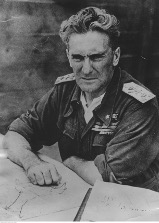
Rodolfo Graziani during the North Africa Campaign
Rodolfo Graziani was a key figure in the Italian Army during ww2, helping with the expansion and consolidation of the Italian colonial Empire. At the start of the war, he returned to Libya as the commander for the Italian North Africa, but decided to resign after the British offensive caused his troops to withdraw.
He became “Marshal of Italy” and was the only one who remained loyal to Mussolini after his demise, and for this he was named Minister of Defence for the Italian Social Republic, commanding its army. He was never prosecuted after the end of the war and later died in 1955.
General Giovanni Messe
Giovanni Messe was an Italian field marshal, who fought during the 2nd World War. He was captured in Tunisia in 1943 but returned to fight against the Germans with the Co-Belligerent Army.
He first fought in Greece, but was later transferred on the Eastern front. He was then sent to Tunisia, as the commander of the Italian-German tank Army. He was promoted to the rank of “Marshal of Italy” but was forced to surrender on the 13th of May 1943.
When the Italian Kingdom decided to fight with the allies, he was brought back to Italy and served as the Chief of Staff for the Co-Belligerent Army. He then retired in 1947.
Amedeo Guillet, The Devil commander

Amedeo Guillet disguised vs Him in his uniform
Amedeo Guillet was an officer of the Italian cavalry, who fought with Amedeo, Duca D’Aosta, during the African campaign. He was the commander of the “Gruppo Bande Amhara”, made up of recruits from the Italian East Africa. He was tasked with the creation of the “Bande a Cavallo”, native units commanded by Italian officers, their job was to conduct guerrilla warfare against the Allies. He was loved by his soldiers and knew that no one would betray him. During his time in Africa he got himself the name:“The devil commander” because of how well his troop were fighting. He managed to avoid capture several times and he even fooled the English by sometimes posing as an Arab and giving them false info of his whereabouts. He returned to Italy in 1943 trying to raise money for his cause but failed. In the end, he retired from the army in 1945 and died in 2010.
Prince Amedeo, Duke of Aosta
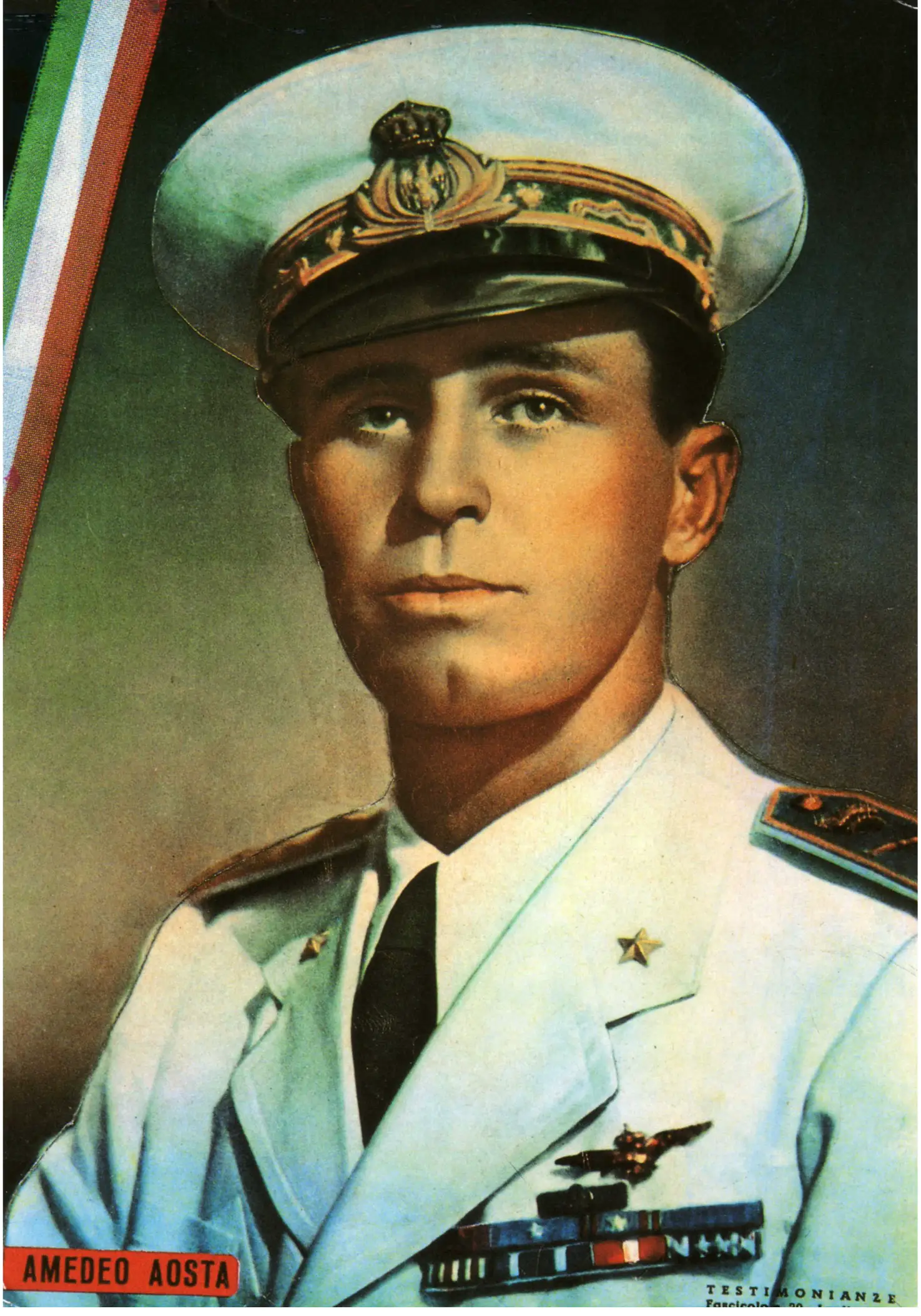
illustration depicting His Royal Highness Amedeo Duca D’Aosta
Prince Amedeo was the Italian Viceroy of the Italian East Africa as well as the Governor General. He was also the commander in chief of the Italian forces in Eritrea, Ethiopia and Somaliland.
At the start of the war he oversaw operations in Sudan and Kenya and the invasion of British Somaliland.
Things quickly went down south for the Italian army and he was forced to surrender himself on the 18th of May 1941. He never saw the end of the war, dying on the 3rd of March 1942 from complications from malaria and Tubercolosis.
Pietro Badoglio
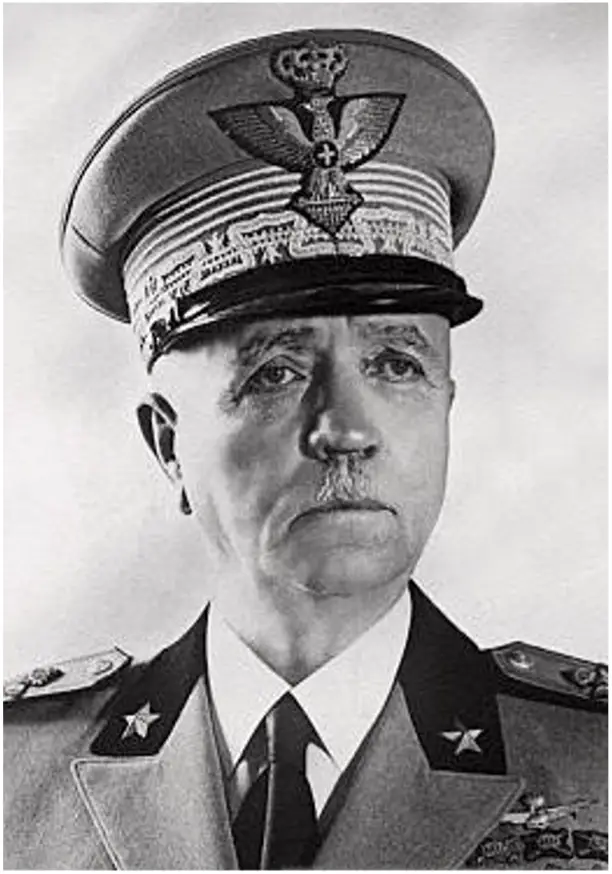
Pietro Badoglio in uniform
Pietro Badoglio was an Italian General and later Prime minister of Italy during ww2. He participated in ww1, being present during the Battle of Caporetto. He was the one who invaded Ethiopia and also used chemical weapons against the population. During the 2nd World War he was not in favour of fighting with the Germans and always viewed the Pact of Steel as something avoidable. Badoglio was named Prime Minister of Italy after Mussolini’s fall and he signed the famous “Badoglio Proclamation”, which declared that Italy was no longer fighting the Allies. At the end of the war he was never processed and later died in 1956.
Benito Mussolini
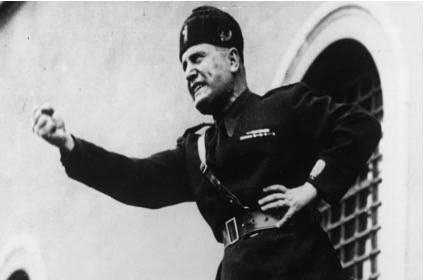
Benito Mussolini during one of his speeches
Benito Mussolini, also called “Il Duce”, was an Italian politician and the founder and leader of the National Fascist Party. He was Prime minister of Italy from 1922 until his deposition in 1943. he later became leader of the Italian Social Republic before being caught and killed by Partisans on the 28th of April 1945 while he was trying to flee Italy.
King Victor Emmanuel The Third
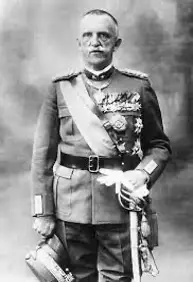
King Vittorio Emanuele III in uniform
He was the King of Italy from 1900 til his abdication in 1946, he also reigned as Emperor of Ethiopia and King of the Albanians. During his reign Italy became involved in 2 world wars.
When Mussolini became Prime minister, he never opposed it and also remained silent in several occasions. During the 2nd World War, he opposed Italy’s entry and also opposed the Pact of steel.
He pressured Mussolini into declaring Italy’s neutrality in 1939. When Mussolini fell in 1943, he installed Badoglio as his successor and ordered the arrest of Mussolini, imprisoning him on the Gran Sasso. When the war ended, the King tried to keep the Monarchy alive, but he himself knew that it was a gigantic task. Vittorio Emanuele decided that his abdication would have helped with the monarchist cause, but in reality it didn’t change a thing. When Italy voted to become a Republic, he and all the other male members of the House of Savoy were required to leave the country. Along with his wife, he took refuge in Egypt and died a year later in Alexandria.